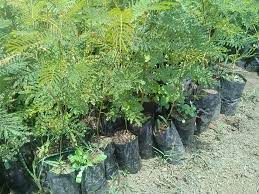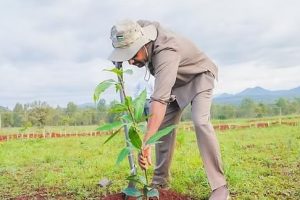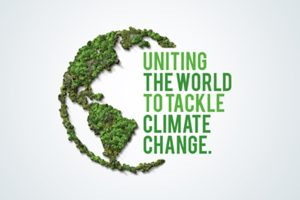
Given Ethiopia’s arable land, Water resources and a large number of productive manpower, the government has found it effective to concentrate its efforts on agriculture to lead Ethiopia into prosperity.
The Ethiopian Green Development Legacy (EGDL) launched in 2019 under the leadership of the reformist and visionary Prime Minister Abiy Ahmed (PhD) is enhancing the goal Ethiopia’s forest cover to 30 percent by 2030 by planting a total of 20 billion seedlings in just four years.
In this Ethiopian fiscal year only, Ethiopia has planned to plant over 7 billion seedlings in Ethiopia and in neighboring countries, besides the over 10 billion seedlings planted over the previous two years, according to information obtained from the Ministry of Agriculture.
Prime Minister Abiy Ahmed has launched recently the 2021 edition of Green Legacy Initiative aimed at planting 6 billion tree seedlings in Ethiopia and one billion in neighboring countries.
“Today as we launch the 2021 edition of Green Legacy Initiative, we refer to the four year challenge we set in 2019, aimed at addressing the consequences of environmental degradation and climate change. Human life is strongly intertwined with trees, and forests beyond preventing flooding, food insecurity, and environment related conflicts and other adverse effects,”
The premier urged all Ethiopians to “Adorn Ethiopia,” a call to cover the nation Green, see beyond lines of division — regional, ethnic, religious, sex, and in unity dress Ethiopia with the prosperity and dignity the people of this great nation deserve.
This initiative ensures Ethiopia’s future prosperity by enabling food security, reducing erosion, preventing dams from filling up, and ensuring the long-term operation of the Grand Renaissance Dam.
With the aspiration to substitute wheat imports, the government has launched a summer irrigation wheat production and lowland irrigation program in 32 Woredas and other areas of Oromia and Amhara regions, as well as in on 20000 hectares of irrigated fields in Afar and Somali regions.
Techniques like building diversion dams, rainwater harvesting, implementing cluster farming, using improved seed varieties and choosing suitable fertilizers have proved effective in ensuring food security and strengthening the agricultural sector.
Having this current and future stance of Ethiopia on the green development, it is essential to augment this not only to benefit the nation, the horn, the continent but also the globe especially those developed countries who have been leading wars against the nature.
To do so, Ethiopia is striving to plant 20 billion tree seedlings up to 2024 through the Green Legacy Initiative that started three years ago. Last year only, the nation led by the visionary leader planted over 4.1 billion trees.
There are several purposes why Ethiopia decided to do so. The first and foremost purpose is restoring the nature to hand over a reliable ecosystem to the next generation.
Restoring ecosystems is protecting their biodiversity and enhancing them to deliver benefits for people and nature. It includes using ecosystems on land and in the oceans in ways that reinforce their natural resources and processes. Planting trees is one of the extremely important actions for restoration as it prevents degradation of land and adds to the survival of the animals becoming extinct.
The other critical reason is to poverty reduction. Greenery is very much related to poverty or they are closely interrelated. Even though much of the environmental destruction is caused by the developed nations, the undeveloped once often bear the brunt of environmental damage.
And they are often caught in a downward spiral, whereby the poor are forced to deplete resources to survive, and this degradation of the environment more deprives people according to the reports of the United Nations Development Program (UNDP) and United Nations Environment Program (UNEP).
As a result, Ethiopia is acting on this responsibly with accountability to tackle poverty in whatever criteria it may be measured.
The third main force behind the Ethiopian Green Development Legacy is the right clean and healthy environment.
The right to a healthy environment is recognized by over 150 UN member states, but it has not been formally recognized at the global level. Thus delaying achievement of the Sustainable Development Goals, exacerbating inequalities, and creating protection gaps, especially for environmental human rights defenders, children, youth, women, and indigenous peoples who often have been and continue to be agents of change for safeguarding the environment.
As a result these people are faced with a triple environmental crisis: climate change, loss of biodiversity and pollution. Rights of present and future generations depend on a healthy environment. The global recognition of the right to a healthy environment will support efforts to leave no one behind, ensure a just transition to an environmentally healthy and socially equitable world and realize human rights for all.
These UN member states have said: “We commend the Council’s leadership for bringing the world closer to global recognition and protection of the right to a healthy environment.
We have come together under the UN Secretary-General’s Call to Action for Human Rights, through the inspiration provided by the Council, and in response to the urgent call for action from all corners of the world to declare that the time for global recognition, implementation, and protection of the human right to a safe, clean, healthy and sustainable environment is now. We stand ready to support Member States in achieving this objective.”
For this global fact, members of the diplomatic community based in Addis Ababa have recently urged the international community to support Ethiopia’s efforts to integrate the Horn of Africa with green development on briefing forum.
Israeli Ambassador to Ethiopia, Alelign Admasu said Ethiopia has made a significant contribution to the African Unity and is now trying to repeat this contribution with the Green Legacy initiative.
He notes that Israel pays great attention to green development and it will work with Ethiopia in this regard adding: “Israel is known for its scientifically developed greenery and agricultural development. The government of Israel is committed to working with Ethiopia to expand the Green Legacy Initiative and ensure its sustainability by providing the necessary supports.”
Similarly the other participant, United Nations Industrial Development Organization (UNIDO) representative to Ethiopia, Aurell Patrizia Calabro said Ethiopia’s effort to connect green development with drought-stricken countries, including Somalia is encouraging.
Noting that green development works for all and it should be cross-border, she said that the entire international community should support Ethiopia’s efforts.
Likewise, Chargé d’Affaires at the Ukraine Embassy in Ethiopia, Oleksandr Zub said the international community must stand together to realize Ethiopia’s focus on green development reaffirming: “Ukraine will support the green legacy development of Ethiopia.”
In addition to these diplomats, State Minister of Foreign Affairs Ministry, Birtukan Ayano has also told the Ethiopian News Agency on the occasion that Ethiopia’s move to integrate the region with its Green Legacy Initiative is in line with its foreign policy that aspire regional integration. “The initiative has been implemented considering the fact that the impact of climate in one of the neighboring countries affects the entire region including Ethiopia.”
Therefore, as the impact of climate change is beyond boundary, the international communities, especially the UN member states and the global organizations like the United Nations Environmental Program must support Ethiopia’s efforts in restoring the nature for the next generation. Restoring the nature is protecting the human rights to clean, safe, providing and healthy environment.
BY DIRRIBA TESHOME
The Ethiopian Herald 30 May 2021





